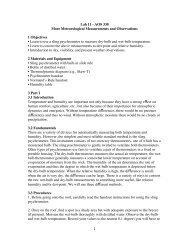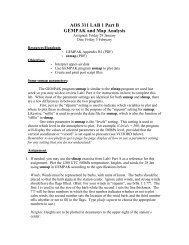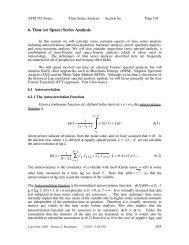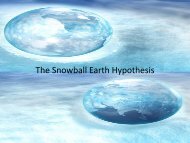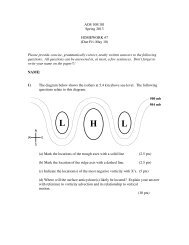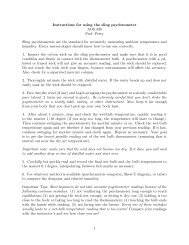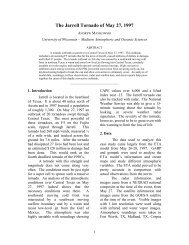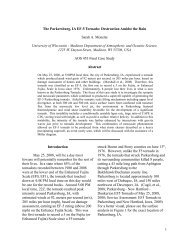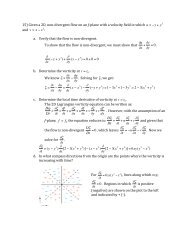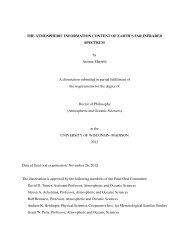Tropospheric Pollution Part II:Aerosols - Atmospheric and Oceanic ...
Tropospheric Pollution Part II:Aerosols - Atmospheric and Oceanic ...
Tropospheric Pollution Part II:Aerosols - Atmospheric and Oceanic ...
You also want an ePaper? Increase the reach of your titles
YUMPU automatically turns print PDFs into web optimized ePapers that Google loves.
<strong>Tropospheric</strong> <strong>Pollution</strong><br />
<strong>Part</strong> <strong>II</strong>: <strong>Aerosols</strong><br />
AOS 171<br />
04/04/13
Outline<br />
• Review last class…<br />
• Where do sulfate aerosols come from?<br />
• Natural <strong>and</strong> man-made<br />
• How are they produced?<br />
• Worldwide production of aerosols<br />
• Climactic Effects of aerosols<br />
• Acid rain<br />
• Summary of <strong>Tropospheric</strong> <strong>Pollution</strong>
<strong>Tropospheric</strong> Ozone<br />
• Result of air pollution from internal<br />
combustion engines <strong>and</strong> power plants<br />
• Exhaust <strong>and</strong> emissions release NOx (Nitrous<br />
Oxide gases), SOx (Sulfur Oxide gases), <strong>and</strong><br />
VOCs (volatile organic compounds), which are<br />
bi-products of burning gas <strong>and</strong> coal<br />
• NOx, SOx <strong>and</strong> VOCs combine chemically with<br />
oxygen to form ozone during sunny warm days
<strong>Tropospheric</strong> <strong>Aerosols</strong><br />
• <strong>Aerosols</strong> enter the lower atmosphere<br />
through...<br />
1) factory <strong>and</strong> auto emissions (human<br />
induced)<br />
2) agricultural burning (human induced)<br />
3) dust storms, forest fires, sea spray <strong>and</strong><br />
volcanoes (naturally)
Sulfate <strong>Aerosols</strong><br />
• The majority of these particles come from<br />
the combustion of sulfur containing fossil<br />
fuels
Another Source<br />
• Over the oceans is a major source of sulfate aerosols<br />
• Phytoplankton produce dimethylsulphide gas (DMS)<br />
when they die<br />
• DMS slowly diffuses into the atmosphere where it<br />
oxidizes to form sulfur dioxide, then converts to<br />
sulfate aerosols
Thermoregulation of the planet through<br />
DMS – James Lovelock<br />
• DMS emitted by phytoplankton in sunlight can<br />
create effective cloud condensation nuclei<br />
(CCN) <strong>and</strong> form clouds<br />
• If there is too much sunlight <strong>and</strong> CCN, clouds<br />
will shut off the sunlight <strong>and</strong> DMS formation<br />
so that the clouds will go away <strong>and</strong> the sun<br />
will come out again
By regulating clouds <strong>and</strong> sunlight phytoplankton help<br />
keep the planet’s temperature near an equilibrium
Air Quality St<strong>and</strong>ards<br />
• In 2010 the EPA revised the primary SO2<br />
NAAQS by establishing a new 1-hr st<strong>and</strong>ard at<br />
a level of 75 ppb
How do sulfate aerosols affect the<br />
temperature of the planet?<br />
• By absorbing <strong>and</strong> emitting infrared, sulfate<br />
aerosol keeps the nighttime warmer than it<br />
would be without them<br />
• By reflecting sunlight during the day, sulfate<br />
aerosol keep the daytime cooler than it would<br />
be without them
Diurnal Range<br />
• The diurnal range has decreased by more than<br />
1 K in the last century<br />
• In major fossil fuel burning regions, radiative<br />
observations show that anthropogenic aerosol<br />
reflects 2 – 10 W m^2 of solar energy back to<br />
space across N. America <strong>and</strong> Eurasia
Box model - Sulfur over the eastern U.S.<br />
• Amount of a constituent is a reservoir (kg)<br />
• The flux of a constituent from one reservoir to<br />
another is given in (kg/s)<br />
• 1 Tg = 10^6 tons (the mass of a million cars)<br />
• Smokestacks <strong>and</strong> vehicles in the eastern U.S.<br />
emit 12 Tg S/yr (flux into the atmospheric<br />
reservoir)<br />
• ~8 Tg S/yr fall back to the ground as acid rain<br />
(flux out of the atmospheric reservoir)
1 Teragram = 1X10^9 kilograms
1 KTonne = 1,000<br />
metric tons
1 Gg (Gigagram) = 1 million kg
1 Gg (Gigagram) = 1 million kg
1 DU = 2.69 10x16<br />
molecules/cm2
Acid Rain<br />
• Rainfall that has been mixed with elements<br />
<strong>and</strong> gases that have caused the moisture to<br />
become more acidic<br />
• Pure water has a pH of 7<br />
• Generally rainfall has a pH of about 6<br />
• Acid rain can have a pH of 5.0-5.5 <strong>and</strong> in some<br />
parts of the world it can have a pH of 4
What causes acid rain?<br />
1. Primary emissions of sulfur dioxide (SO2) <strong>and</strong><br />
nitrogen oxides (NOx) resulting from fossil fuel<br />
combustion<br />
2. Sulfur in the air combines with oxygen to form<br />
sulfur dioxide (SO2)<br />
3. Car exhaust causes nitrogen oxides in the air<br />
(NOx)<br />
4. From (SO2) <strong>and</strong> (NOx) airborne sulfuric acid<br />
(H2SO4) <strong>and</strong> nitric acid (HNO3) can be formed<br />
<strong>and</strong> dissolved in water vapor
H2SO4 (sulfuric acid)<br />
HNO3 (nitric acid)<br />
Degrades waxy coating<br />
Destroys chlorophyll<br />
Causes necrotic tissue<br />
Mycorrhiza (root hairs) are<br />
killed by acid rain<br />
Nutrients are leached<br />
out of water
Acid rain <strong>and</strong> statue degradation<br />
• Calcium carbonate, the main component of<br />
marble, is not soluble in water.<br />
• Acids contained in acid rain transform CaCO 3 ,<br />
by chemical reactions, into soluble salts<br />
which are washed away, giving rise to the<br />
formation of holes on the surface of the<br />
artifacts
S<strong>and</strong>stone figure over the<br />
portal of a castle in<br />
Westphalia, Germany,<br />
photographed in 1908<br />
(left) <strong>and</strong> again in 1968<br />
(right)
<strong>Tropospheric</strong> <strong>Aerosols</strong> Summary<br />
• <strong>Aerosols</strong> enter the lower atmosphere<br />
through...<br />
1) factory <strong>and</strong> auto emissions (human<br />
induced)<br />
2) agricultural burning (human induced)<br />
3) dust storms, forest fires, sea spray <strong>and</strong><br />
volcanoes (naturally)
Summary<br />
• Anthropogenic aerosol reflects 2 – 10 W m^2<br />
of solar energy back to space across N.<br />
America <strong>and</strong> Eurasia<br />
• Acid rain - From (SO2) <strong>and</strong> (NOx) airborne<br />
sulfuric acid (H2SO4) <strong>and</strong> nitric acid (HNO3)<br />
can be formed <strong>and</strong> dissolved in water vapor
Next Class…<br />
• Homework 2 is due<br />
• Biodiversity <strong>and</strong> climate stability<br />
• Gaia hypothesis<br />
• Daisy World<br />
• Chaos Theory <strong>and</strong> Climate Stability



